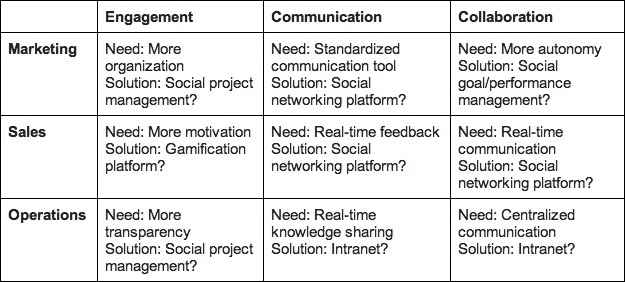Over the last few years, social and mobile technologies have proven to be powerful tools for sourcing and recruiting talent. More recently, we’re beginning to see consumer tech–social, in particular–being leveraged in other HR functions. But while research shows these next generation tools have the potential to improve communication and collaboration across the enterprise, business leaders are left with one question: “Who takes ownership of these tools?”
Call me crazy, but… Why not HR? By teaming with IT, and driving the adoption of these next generation tools, HR could upgrade its role in Enterprise 2.0. There’s just one problem: HR must first shed its old-school role of communications cop.
Old Habits Die Hard
It’s no secret that social and mobile technologies make HR leaders nervous. Many have earned a reputation for policing interoffice communications, but this old habit is counterproductive.
“We hurt our corporate reputations when we attract candidates through contemporary use of social media, and then revert back to our old ways and block employees from using social tools to do their jobs,” says Cindy Lubitz, Founder of inTalent Consulting. As she sees it, this double standard that is becoming a growing problem.
While mitigating risk is important, HR can do more by taking a proactive approach to new tech. By moving away from the stereotype of communication cop and redefining itself as a communication catalyst, HR can play a more strategic role.
Three Steps for Upgrading HR’s Role in Enterprise 2.0
The strategic play for HR is to team with IT to assess needs, research solutions, and implement new technologies enterprise-wide. Of course, game plans for embracing consumer IT will vary, but there are some general steps in the process to get HR strategically involved in the selection, implementation and use of social technologies.
First: Identify Needs, Research Solutions
Before you can begin strategizing for improvement, you need an accurate picture of where things stand. Survey employees, managers and department heads. Discover how teams communicate and collaborate today, and what needs employees have that they’re not solving today.
Then, research technology solutions. While you short-list some tools, keep in mind that the best solution may not be a new tool but rather using a tool already in use in a different way.
Second: Align Department Needs to Business Goals
It’s important to understand that social tools aren’t one-size-fits-all. And if you’re trying to achieve high-level business goals like improved employee engagement, what works for one department, may not work for another. For example:

HR is uniquely positioned in the enterprise to identify needs–individual, departmental, regional–and tie those needs to business goals. By bringing department heads and regional managers together with IT, HR can facilitate an implementation strategy that works for everyone.
Step 3: Collaborate with IT on Implementation
Cloud-based tools like Empxtrack don’t require much technical heavy-lifting, but adoption can be a challenge. HR should focus on internal communications to promote adoption of the new tools and best practices around their usage.
It’s also effective to get your employees involved. At Software Advice, for example, Marketing employees recorded video tutorials for various tools we use. They’re useful, but they also gave employees a chance to share some insider information–and play a part in driving adoption.
For HR, Resistance is Futile
There are bound to be hiccups when opening channels for employees to exchange ideas and information in real-time. But the greater risk with these types of tools is that heavy-handed moderation can have a direct impact on your company’s investment in these technologies.
HR departments fighting for a seat at the table aren’t doing themselves any favors by resisting innovation in workplace technology. If HR can focus on strategies to maximize return on investment, rather than policing use, they could position themselves as a major contributor in the social enterprise.
“KyleLagunas is the HR Analyst at SoftwareAdvice—an online resource for reviewing and comparing talent management software. He’s a tech enthusiast, and focuses on keeping his audience in touch with important trends and hot topics in the industry. Connecting with thought leaders and in-the-trenches professionals, and offering a fresh take on best practices in recruiting, human resources, and talent management”



It seems like you have made a deep research on it, However, the role of HR department in every industry is of great importance as they manage their human resources in a more efficient and productive manner and for it they should use human resource management software’s to do their work in a more precise manner.
It may be worthwhile for Business Schools & other institutions offering Human Resource Management programs to read this article and align their syllabi to enable creation of next generation HR professionals who understand the importance of HR – IT collaboration to trigger strategic HR initiatives. These change agents have to roll out of the academic institutions. Resistance of the old generation HR can perhaps be overcome by creating an echo system with its foundation in education.
Hope to hear the views of others on the need for ‘HR – IT Collaboration’.